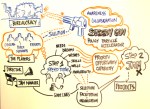May 17, 2015
In March 2015, I was challenged by Marek Pawlowsky from MEX to do something unique to inspire the UX designers’ community and to show them the potential of Lego Serious Play.
Marek is not a novice, being a participant into one of my past workshops, and the challenge was exciting enough for me to accept it!
The goal of the session was to inspire, entertain, make the audience curious, intrigue them, challenge their ordinary ways of thinking, introduce them to new ideas, theories and opportunities.
I’ve imagined how would a speed dating with LSP look like and this is what happened…! (more in the next page)
Patrizia Bertini demonstrates Lego Serious Play and considers creative methods for future experience design from Marek Pawlowski on Vimeo.
read more »
Posted in Events & Fun, LEGO SERIOUS PLAY, Methodology, theory, ux, Video |
Leave a Comment »
February 8, 2015
In the era of exclu sivity, how can inclusivity survive and be attractive?
sivity, how can inclusivity survive and be attractive?
It’s time to change the rhetoric around accessibility and include accessibility in the wider framework of the world we live in.
We cannot talk about inclusivity in a society that promotes exclusivity as a status symbol and a value we need to reach.
In the age of wellness and eternal youth, none wants to acknowledge that sooner or later our physical and/or cognitive abilities will fade and we’ll become elder, eventually with some cognitive or physical impairment.
Today, ageing and the natural and biological transformations we are all subject to, are tabus: in a world where drugs and surgery can fake appearance and let us forget about time, it’s easy to forget that behind apparently smooth faces there is still an ageing body.
Our society rejects the thought of ageing, refuse to accept that we won’t be young forever, that technology cannot (yet) make us to stay young for ever.
How can then we convince such a society about the importance of accessibility and inclusivity?
read more »
Posted in accessibility, theory |
1 Comment »
November 15, 2014

Facilitation’s thorny issues
Facilitating is an art. it requires a mix of personality traits, like the ability to guide and lead a group, a set of knowledge about group dynamics, psychology, and techniques.
A facilitator is usually an external member, someone who enters into a group and guides them through a journey to get to a goal. The design part is the key: a facilitator always needs to know exactly where the group is, the next steps, the timing of every activity and include any eventual recovery plan in case something does not goes according to the plans.
Facilitator’s personality is another essential factor: the facilitator needs to be able to engage and lead the group, mitigate power games and dominant personalities and to involve shy and silent people without putting pressure.
All is clear, until the facilitator faces a challenge: facilitate within a group they know well.
read more »
Posted in LEGO SERIOUS PLAY, Methodology, theory |
1 Comment »
June 20, 2014

© Patrizia Bertini
In the past few years, the number of articles published around Lego Serious Play is hugely increased.
The initial theories developed in the mid ’90s, 20 years ago, by Johan Ross and Bart Viktor and put into its current shape by Robert Rasmussen, are today converging and mingling with new trends and emerging needs.
What was supposed to simply be a language, communication tool, problem solving methodology, based on the belief that everyone can contribute to the discussion, the decisions, and the outcome, it has become a tool for exploring, both a crinkly and torn treasure map to be completed with the imagination of the facilitator and the participants, and a hammer to deconstruct and construct new opportunities.
read more »
Posted in LEGO SERIOUS PLAY, Methodology, theory |
3 Comments »
May 22, 2014

Co-creation in action
Co-creation: who should be involved?
When saying all stakeholders we do not refer to the largest majority of users available, as they can be reached with crowdsourcing initiatives. It’s not about quantity, but quality. As several studies from early ’90s have demonstrated, involving lead users, who are those individuals that have needs that are advanced with respect to an important marketplace trend and expect to benefit significantly by obtaining a solution to those needs (Herstatt & Von Hippel 1992) can have a significant impact on the results, proving that quantity is not synonymous of quality.
read more »
Posted in cocreation, Organisations, theory |
3 Comments »
May 3, 2014

The Cluetrain Manifesto
The beginning of the revolution: the Cluetrain Manifesto
Co-creation has become a very sexy world in the business news. Newspapers and magazines are full with inspiring titles, like 5 Co-creation Examples: E.ON, Coca-Cola, MTV, Tata Group & Heineken, 5 examples of how brands are using co-creation, How Coca-Cola uses co-creation to crowdsource new marketing ideas.
However, the understanding of this term is often blurred and organisations use the word co-creation to refer to many different things, which share one key concept: the involvement of users and the conversations between users and organisations.
read more »
Posted in cocreation, Organisations, theory |
2 Comments »
April 21, 2014

LEGO Serious Play used to co-create new services at Bologna Global GovJam 2013.
Lego Serious Play is a facilitation method that was designed in ways to enhance business performance by bringing around the table key stakeholders and by facilitating the discussion and meaning sharing activities through the use of LEGO bricks, metaphors and storytelling.
LEGO® SERIOUS PLAY® is a method that allows participants to negotiate decisions and strategic and operative plans and to co-create ideas creatively, socially and interactively. Thanks to the peculiar collaborative and social dynamics enacted by the method, all participants in an LSP workshop contribute to the discussion and to the decisions. The LEGO bricks act as co-creation tool and as a communication mediator: bricks are both a media to build and express complex ideas through storytelling and metaphors, and bricks act as a mediator between participants, allowing people to overcome hierarchies and power games that often affect workshop like activities and co-creation initiatives.
read more »
Posted in cocreation, LEGO SERIOUS PLAY, Methodology, theory |
4 Comments »
June 7, 2013

LSP @ GovJam
What if I apply LEGO SERIOUS PLAY to a Jam?
I should not ask myself such questions, because when I ask myself this, I want to find out the answer. So, my latest experiment was applying LSP to a GovJam. For those who are unfamiliar with the Jam concept, a Gov or Service Jam is a global event, taking place simultaneously all around the world for 48 hours, where participants, called jammers, are called to design a service or a product on a common secret theme, which is revealed just at the beginning of the Jam. The name Jam is taken by music: in a jam session musicians improvise on a common theme and make music together. The idea in a Jam of ideas, is the same: let people improvise and jam with their ideas to make new ideas together.
In a GovJam, the goal is to design a service aimed at the local public administration. Knowing how LSP can be flexible and how helpful it is when it comes to define a common topic and for team building, I thought it could be an exciting challenge to imagine and design a LEGO SERIOUS PLAY workshop to enhance creativity and let people to jam ideas with bricks.
This turned out to be an exciting designing exercise which has been demanding but rewarding as well. Designing an LSP workshop for a Jam, revealed a number of key differences with the design of a ‘traditional’ workshops and this challenge lead to a dynamic, exciting and challenging workshop management. Thanks to the experience, I have had kind of a guerilla training in managing the unexpected and I have learnt a number of useful issues which will be useful for future workshop design.
So, I have identified 5 variables that should be taken into consideration when designing a workshop in any other situation where nothing is given and everything is improvised and based on the play-do-play-do mantra.
read more »
Posted in LEGO SERIOUS PLAY, Methodology, theory |
3 Comments »
March 27, 2013
For those who were not there and for those who want to keep reflecting on the contents presented on Saturday 23rd March in Ferrara [Italy], here are the Keynote speakers’ presentation. A big thank you to all the speakers who agreed to share their precious and inspiring material!
Robert Rasmussen, Rasmussen Consulting (Denmark) | The LEGO SERIOUS PLAY method: a thinking, communication and problem solving techniques for groups insights to its the origin, purpose, functionality and theoretical underpinnings.
This slideshow requires JavaScript.
read more »
Posted in Architecture, education, Events & Fun, LEGO SERIOUS PLAY, theory |
1 Comment »
March 2, 2013

How can we access Knowledge?
This question was triggered by Slobin’s book, Psycholinguistics, originally written in 1971 that I was reading in its second edition.
Slobin reflects on language and the role of psycholinguistics, and there he states that “language, like all systems of human knowledge, can only be inferred from careful study of overt behaviour. […] It is important to grasp the distinction between overt behaviour and underlying structure. In English and other languages, the distinction is expressed in the concepts of LANGUAGE and SPEECH: SPEECH has a corresponding verb form, whereas LANGUAGE does not.” (Slobin 1979 :2).
This distinction reminds Saussures’ Langue and Parole, when he says that language should be considered as the norm of all other manifestations of speech (1916 :9). Though Slobin, by pointing out the active nature of speech, that corresponds to a verb, to an action, has brought in something I have found worth a thought. So, what if we shift Slobin’s definitions and equal knowledge to language and speech to the act of meaning making?
read more »
Posted in education, Epistemology, theory |
3 Comments »


 sivity, how can inclusivity survive and be attractive?
sivity, how can inclusivity survive and be attractive?





